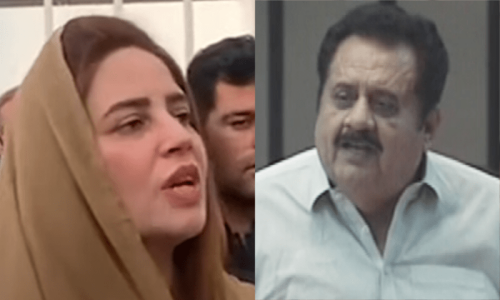SINDHI Culture Day was celebrated this month: television channels broadcast songs, shows and skits celebrating Sindhi culture and all its symbols: ajraks, Sindhi topis, rilis and matkas.
Poets and musicians recited and sung the verses of Shah Abdul Latif and Lal Shahbaz Qalandar, and we Sindhis were reminded of the greatness of our cultural heritage, which includes Mohenjodaro, Sehwan Sharif, the Thar desert and the Indus river. In Karachi, Jeay Sindh Jeay by Ahmed Mughal, the unofficial anthem of Sindhi Culture Day, blasted from loudspeakers and men dressed in topis and ajraks danced happily long into the night.
But what do these symbols really mean, beyond their function as identity markers, and are we limiting ourselves by elevating them to the status of objects of veneration, without really placing them in their proper context?
I was prompted to ask this question while attending a lecture by the French researcher Dr Julien Levesque, who is here in Sindh for doctoral research on Sindhi identity, on the representation of Sindh in visual imagery. Levesque analysed how these symbols have become shorthand for the concept of Sindh and Sindhiness, yet they fall far short of telling the real story of a modern, living and breathing culture.
Levesque used examples from movies, music videos, paintings and photographs to illustrate an obsession with a ‘pure’, idealised version of Sindhi life firmly rooted in the rural traditions of an agrarian society. This portrayal ignores how so many Sindhis have sought to transcend the rural environment, moving to Sindh’s urban centres in search of better opportunities in education and economy. It also ignores the changes in Sindh’s ethnic makeup, the emigration of Sindhi Hindus after Partition, and the migration of Pakhtuns, Afghans and Urdu-speaking Mohajirs over the last several decades.
Sindhi Culture Day came about in part as a reaction to comments made by television anchor Dr Shahid Masood, who criticised then president Asif Zardari for wearing a Sindhi topi and ajrak, saying that it showed obvious bias towards one province over the others that made up the federation. Was this truly appropriate national dress, he asked?
But there’s a deeper motivation at work behind Sindhi Culture Day — fear. Since the creation of Pakistan, Sindhis have worried that they would lose their language and culture. This caused prominent Sindhi intellectuals to attempt to ‘fix’ Sindhi culture in a timeless vacuum. The Sindhi Adabi Board, established in 1951, began a process of selecting symbols that would represent Sindhi culture, taking previously unselfconscious cultural practices and turning them into permanent overarching symbols of Sindh and Sindhiyat.
The Institute of Sindhology, established in 1961, continued this process, which Levesque terms “the colonial state turning flexible identities into rigid types and categories”. A glance at the museum in Jamshoro with its permanent tableaus of a Sindhi Thari homestead, a Sindhi Hindu family, and a Memon household peopled with inanimate mannequins speaks ironic volumes about the intellectual attempt to construct a definitive representation of Sindh for all time.
The folklorisation of Sindhi culture, the fetishisation of the ajrak and topi beyond identity assertion may be a feel-good gesture to appeal to popular sentiment, and may help shore up the connections that many Sindhis seek to maintain between their urban existence and their rural roots.
Yet this ultimately limits Sindhis and has long-term negative effects: we end up rewriting our culture and history. We also turn ourselves into a caricature that others can use against us to keep us restricted to the country bumpkin role that suits a national narrative where Sindh and its people need to be ‘managed’ by the existing hegemony.
Many Sindhis remember the terrible period of the 1980s and early 1990s when to openly display signs of being Sindhi could result in death in certain quarters and no-go areas, because of the tremendous ethnic conflict between Sindhis and Mohajirs. Those times are long gone, and Sindhis finally feel secure in being able to wear the topi and ajrak and speak Sindhi again, a very positive development.
However, the symbols run the risk of becoming empty vessels if we do not recognise that they are “containers, not content”, according to Levesque. This can only happen when Sindhis critically examine their society in order to place those symbols in their proper context: Sindh as it exists today, not the idealised Sindh of centuries gone by. “Sindhis must try to study their society by using observation and participation,” says Levesque, and need “a little deconstruction and critical thinking” in becoming aware of the risks and consequences of relegating Sindhi culture to a proscribed definition too narrow to reflect reality.
Levesque gave an example of how Sindhi culture can be contextualised today: the PTV drama serial Marvi, a modern retelling of the traditional Sindhi folktale of Marvi and Umer the Soomro king. By placing it in present times, the serial conveyed Sindh’s culture without romanticising or exoticising it; yet the programme was socially critical, and portrayed the challenges of Sindhis trying to negotiate a modern society.
Sindh and its people have to move beyond symbols. We need a larger, fuller picture of who we are, that includes what’s happened in and to Sindh and its people. We can’t continue to define ourselves by what we put on our heads, and ignore what’s really going on inside those heads. Nor can we represent ourselves by the cloth we put on our bodies unless those bodies have a strong sense of where they’re going today and tomorrow. This is the only way our Sindhi culture will continue to have both relevance and resonance for our times and for the generations yet to come.
The writer is an author.
binashah@yahoo.com










































